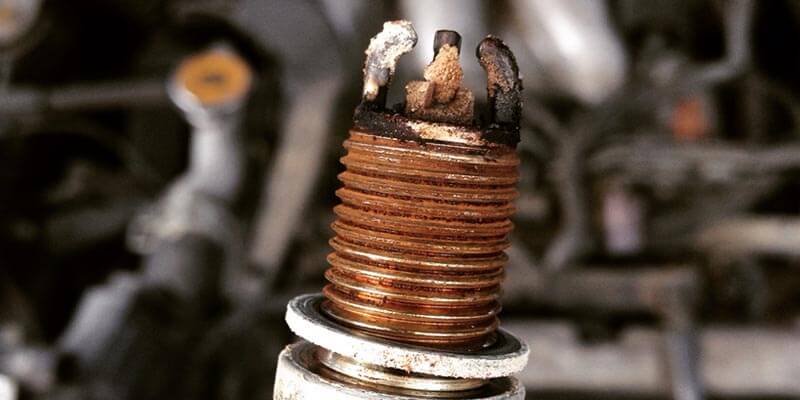A smashed spark plug is one of the most typical plug damages. But what causes a smashed spark plug? Well, to be honest, there are a few factors behind it.
If you have proper knowledge about it, chances are you can easily avoid this problem. So, let me give you all the information regarding the smashed spark plug.
What Do Spark Plugs Do
Consider spark plugs to be the tiny flash of lightning for your Engine. The small but powerful spark of electricity emitted by the plug across a short gap ignites the combustion required to start your car.
Your car can power up, stay powered up, and create a smooth burn of the compressed air-fuel mixture by moving the pistons in the Engine.
On the other hand, spark plugs like it hot: they’re designed to burn off deposits from gasoline additives or other pollutants and can survive intense heat and pressure within your cylinders.
So, your automobile won’t start or go anywhere without a spark because spark plug condition is tied to engine performance. So that is why a bad spark plug can damage the Engine, and a good spark plug can keep it in good health.
4 Major Causes of Smashed Spark Plug
A spark plug can fail due to a variety of issues, including
- Inappropriate heat ranges
- Incorrect Spark Plug
- Improper gapping
- Incorrect Torque
1. Inappropriate Heat Range
The “heat range” of a spark plug refers to how well it disperses the heat it absorbs. Spark plugs with a high heat dispersal are referred to as high heat range (cold type), whereas those with a low heat dispersal are referred to as low heat range (hot type)
A “hot” spark plug has quite a bigger insulator, which prevents heat from entering the water jackets. It retains more heat in the spark plug’s tip, which aids in the removal of combustion chamber deposits.
A “cold” spark, on the other hand, comes with a shorter insulator. At the tip end, it retains less heat. However, you may see deposits build up if it gets too cold. For which, it may become foul.
If you don’t choose the right heat range for your car, you will end up with a bent spark plug tip.
2. Not the Right Spark Plug
One of the most common reasons for spark plugs to get smashed after a while is that they weren’t the right fit for the car engine. A spark plug that is overly long can get into the combustion chamber and strike the piston or a valve. Sometimes we have seen scenarios where piston hitting spark plug 2 strokes.
This has the potential to fracture not just your spark plug into the piston but also the piston itself or damage the head. A bucking engine is caused by a spark plug that is too short.
The spark will not properly ignite your fuel, resulting in poor gas mileage and the activation of your check engine lights. So, size too big and small also has a large impact on the Engine.
3. Improper Gapping
When the spark plug gap is poorly set, it might cause engine problems. Along with a smashed spark plug, you will also face loss of power, spark plug fouling, misfires, plug-wearing, or poor gas mileage.
If the gap is too tiny, the spark will be too weak to complete the combustion process within the engine; if the space is too large, the spark plug will not ignite properly, resulting in misfires at high speeds.
The heat range of a spark plug refers to the temperature of the core nose of the spark plug. Despite this, 90 percent of spark plug damage claims are the result of improper torque.
The ability of the plug to transfer heat out of the combustion chamber and into the cylinder head is dependent on proper installation torque.
When installing spark plugs without utilizing a torque wrench might result in over-torquing or under-torquing the plug, causing damage to the plug and possibly the Engine.
4. Incorrect Torque
Despite all the other reasons, most engineers believe that 90 percent of spark plug damage claims are the result of improper torque. Torque is the process where you apply speed and force to install the spark plug.
The ability of the plug to transfer heat out of the combustion chamber and into the cylinder head is dependent on proper rotation. The spark plug might get smashed while the installation process is underway if you don’t utilize the proper torque wrench.
Otherwise, it might result in over-torquing or under-torquing the plug, causing damage to the plug and possibly the Engine.
How to Remove Crushed Spark Plug?
When you notice that your spark park electorate is crushed due to any of the three reasons we have mentioned, your best bet is to remove the old one and install new spark plugs. For this process, you would need a few tools:
- Oil
- Boot
- Torque wrench
- Spark plug socket
Now let’s talk about the process:
Locating the Spark Plug
Locate the spark plug (the spark plug may be hidden behind the top intake manifold, ignition coil, or cover). Try to locate the line linked to the spark plug or ignition coil.
Pour Oil on It
Pour some oil on the spark plug to make the process smoother.
Unplug the Connector
Unplug the wiring connector on the coil or pull on the boot. If you tug on the wire, you risk harming the wire or the wiring connector. When removing a coil, make sure to use the appropriate tools.
Insert the Socket
After removing the wire or coil:
- Remove the spark plug with your torque wrench and spark plug socket.
- Insert the socket into the spark plug and rotate the wrench counter-clockwise. The spark plug should be easily unscrewable.
- If you’re having trouble removing a too-tight spark plug, stop before you tear it off.
How to Change Spark Plugs
Now that you have removed the damaged spark plug, you need to install new ones.
1. Inserting the New Spark Plug
Before replacing the replacement spark plugs, double-check that the product code on each plug matches the part number and description on the package.
Examine each new spark plug for any signs of wear and tear. Try to find clean and straight threads, an unbroken electrode and tip, and a cracked or chipped insulator for the plug wire or COP boot.
Some spark plugs are pre-gapped and do not need to be re-gapped. Inspect the head of these spark plugs to ensure it is not. Make sure the tip of these spark plugs isn’t bent or broken. Check the gap on various brands and types of plugs to make sure it matches the plug gap requirements on your Engine.
On most, but not all, spark plug brands and kinds, a tiny amount of anti-seize may be utilized. Check the package or the manufacturer of the plug. Install each replacement spark plug carefully, taking care not to cross-thread the spark plug or cylinder head threads.
Make sure to twist the bolts to the required torque. Check your owner’s handbook or the spark plug box for more information. You’ll need a torque wrench, which you can get from your local AutoZone.
2. Re-Install the Ignition Coils or Spark Plug Wires (COP)
Re-install each plug wire or ignition coil after applying a tiny amount of plug wire lubricant to the plug wire boot (or COP boot). Ensure that the plug wires are connected to the correct spark plug and that too in each engine cylinder.
Install the coil hold-down bolt once more. Connect the electrical connector again. To regain access, re-install all other components that were uninstalled.
Make sure you have all of your tools and that the Engine is ready to go. If the battery was detached at the start, remember to reconnect it.
3. Finally, Turn on the Engine
Starting the Engine after replacing the spark plugs is a fantastic technique to check your work. Note: If your Check Engine Light is illuminated, you can take your car to an AutoZone store to have the code decoded.
There is a cylinder miss-fire if the Check Engine Light flashes.’ Check your work again. If the Engine is missing, do not drive the vehicle too far because the catalytic converter may be damaged.
FAQ
It can (and most likely will) cause major engine damage (up to a catastrophic engine failure). Get your car hauled to a shop and have the broken plug parts removed. In addition, get the oil changed (probably with a flush, too, to remove all the debris).
Vibrations, difficulty in acceleration Misfires, poor gas mileage. Hard starts, and rough idling, are all symptoms of faulty spark plugs. In addition, it will be difficult to drive with a faulty spark plug since the Engine may fail to function.
There are compression-ignition gasoline engines in development. It will be able to function without a spark plug. However, for now, the ignition of a regular engine, on the other hand, requires the use of spark plugs. Spark Plugs are used in larger gas or petrol engines, but small engines used in miniature planes, railways, or boats can run without them.
Conclusion
So, after reading till the end, I hope you have found the answer to your question, what causes a smashed spark plug. There are mainly four reasons for this problem.
So, try to avoid these scenarios. Install the right spark plugs with proper gapping. In any confusion, call the manufacturing company or ask the salesman in the shop before buying.

